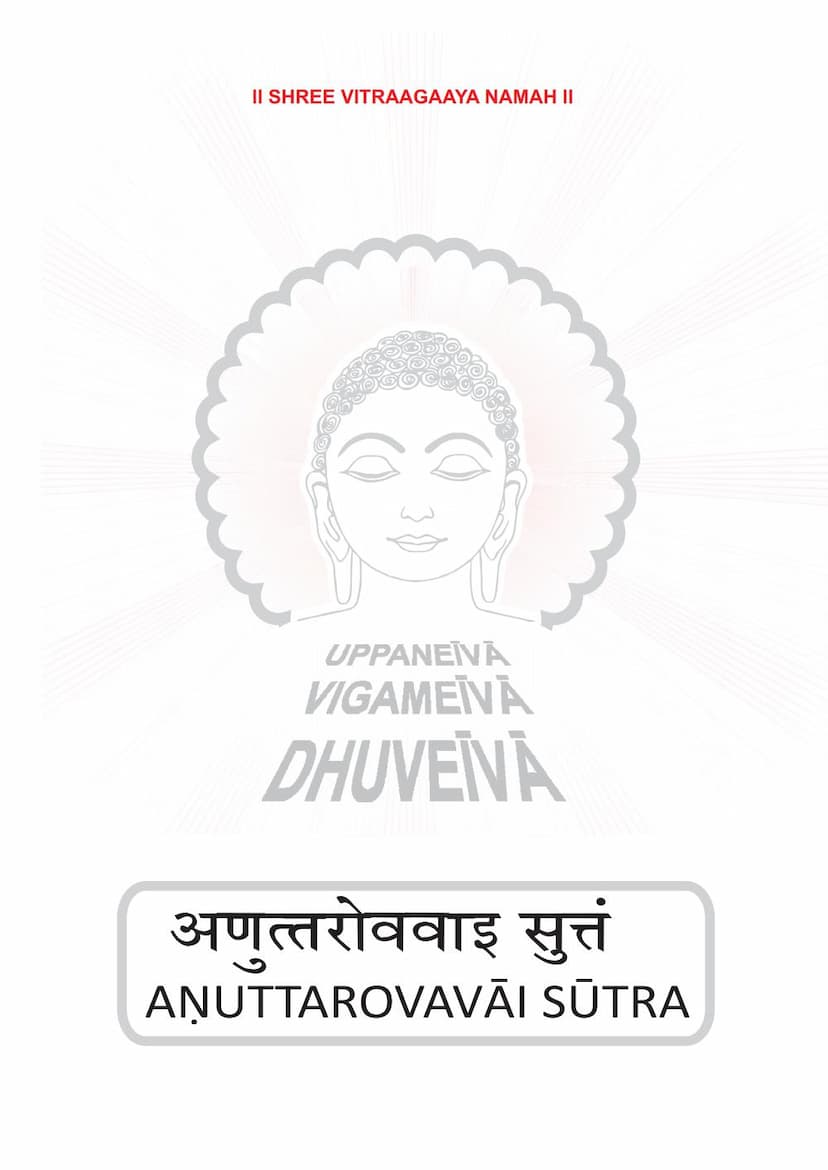Agam 09 Ang 09 Anuttaropapatik Sutra Mool Sthanakvasi
Added to library: September 1, 2025

Summary
Here's a comprehensive summary of the "Anuttaropapatik Sutra" based on the provided text, focusing on its content and structure:
Book Title: Agam 09 Ang 09 Anuttaropapatik Sutra Mool Sthanakvasi Author(s): Sudharmaswami, Devardhigani Kshamashaman Publisher: Global Jain Agam Mission
Overview and Purpose:
The Anuttaropapatik Sutra (Sutra of Those Who Ascend to the Highest Realms) is the ninth Anga (limb or scripture) of the Jain Agamas. It is presented as a collection of precepts of Bhagwan Mahāvīra, originally composed by the fifth Gaṇadhara, Śrī Sudharmaswami, and later compiled and organized by Devarddhigani Kṣamaśramana.
The primary purpose of this Sutra is to detail the births and rebirths of individuals who achieve the highest spiritual states (Anuttara). It describes their lives, their renunciation, and their ultimate attainment of liberation (moksha) in the highest heavens or pure realms. The text emphasizes the importance of rigorous asceticism, renunciation, and the adherence to Jain principles for achieving such elevated states.
Structure of the Sutra:
The Sutra is structured into three Vaggas (sections), each containing a series of Adhyayanas (chapters):
-
First Vaggā: Contains ten Adhyayanas.
- The first Adhyayana details the story of Jāli Kumāra. It describes his life of luxury, his renunciation upon hearing the teachings of Bhagwan Mahāvīra, his ascetic practices, and his rebirth in the Vijay dimension of the heavens. His lifespan in this celestial realm is stated to be thirty-two sāgaropama (a unit of celestial time). Ultimately, he is destined to attain liberation in Mahāvideha.
- The remaining Adhyayanas (2-10) of the first Vaggā are presented as being similar in structure and content to the first, focusing on the stories of other individuals who attained similarly high spiritual states. The text mentions that there were seven sons of Dhāriṇī (a queen of King Śreṇika), and the details of their renunciation and rebirth are elaborated.
-
Second Vaggā: Contains thirteen Adhyayanas.
- This section focuses on thirteen individuals, including Dīghasena, Mahāsena, Lathdanta, Gūḍhadanta, Śuddhadanta, Halle, Dume, Dūmasena, Mahādūmasena, Śīha, Śīhasena, Mahāśīhasena, and Puṇyasena.
- The first Adhyayana of this Vaggā describes the story of Jamma Kumāra (likely a variation or retelling of a similar narrative). The text indicates that the individuals mentioned in this Vaggā also followed similar paths of renunciation and asceticism, with some of them renouncing after sixteen years of spiritual practice, while others did so after shorter periods. Their ultimate destinations in the heavens and eventual liberation in Mahāvideha are also highlighted. The concept of māsiya saṁlehana (a specific form of asceticism) is mentioned as being practiced in both Vaggas.
-
Third Vaggā: Contains ten Adhyayanas.
- This section details the lives and spiritual journeys of ten more individuals, including Dhanne, Sunakshatra, Īśīdāsa, Pellaka, Rāmaputra, Candimā, Piṣṭhimā, Pedhālaputra, Poṭṭila, and Vēhalla.
- The first Adhyayana elaborates on the story of Dhanne Kumāra. It describes his life as the son of a wealthy merchant (Bhaddā Sārthavāhī), his upbringing, education in 72 arts, and his eventual renunciation upon hearing Bhagwan Mahāvīra's discourse. The text details his severe ascetic practices, including fasting and self-mortification, which led to a visibly emaciated and transformed physique. His story highlights his unwavering commitment to his vows and the profound impact of his penance. He is stated to have attained liberation in the highest heaven, Sarvārthasiddha, with a lifespan of thirty-three sāgaropama, and is destined for final liberation in Mahāvideha.
- The story of Sunakshatra is then presented, following a similar pattern of renunciation and asceticism as Dhanne. The text mentions that the remaining eight Adhyayanas of this Vaggā follow a similar narrative structure, highlighting the lives and eventual liberation of these individuals. The text also notes that many of these individuals had multiple wives and experienced opulent lives before their renunciation.
Key Themes and Concepts:
- Renunciation (Nishkramana): A central theme is the renunciation of worldly pleasures and possessions by individuals, often from royal or wealthy backgrounds, after being touched by the teachings of Bhagwan Mahāvīra.
- Asceticism and Austerity (Tapa): The Sutra extensively details the rigorous ascetic practices undertaken by these individuals, including severe fasting, self-mortification, and adherence to strict vows. These practices are portrayed as the means to purify the soul and overcome karmic impediments.
- Karma and Rebirth: The text implicitly emphasizes the law of karma, showing how actions in this life lead to specific rebirths in celestial realms or ultimately to liberation.
- Spiritual Attainment: The core of the Sutra is about achieving the "Anuttara" – the highest realms or states of existence, which are precursors to final liberation.
- Devotion and Faith: The narratives showcase unwavering faith and devotion towards the teachings of Bhagwan Mahāvīra and the principles of Jainism.
- Ultimate Liberation (Moksha/Siddhi): The ultimate goal described for these individuals is the attainment of moksha, the complete liberation from the cycle of birth and death, often achieved in the region of Mahāvideha.
- Sainthood and Spiritual Prowess: The individuals described are depicted as exemplars of spiritual strength, discipline, and detachment, achieving a state of profound detachment from worldly desires.
Publishing and Context:
The Global Jain Aagam Mission has undertaken the project of translating and publishing all Jain Agamas into English to make these scriptures accessible to a wider audience, particularly the youth. The text is presented in Ardhamāgadhi, an ancient Prakrit language. The publication is dedicated to the memory of Pujya Shree Prāṇalālji M.S. and is part of a larger effort to promote Jain teachings globally.